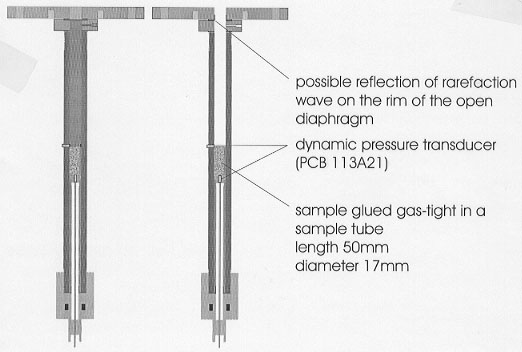

In addition to the investigation of pyroclast petrogenesis, experimental fragmentation of magma provides insights into fragmentation mechanisms that are not possible from field studies alone. Using a set of two PCB dynamic pressure transducers (resonant frequency 500 kHz), the speed of magma fragmentation, initiated by rapid decompression has been measured for two different magma types.
The samples are 50 or 60 mm long and have diameters of 17 and 26 mm respectively. The samples are placed into the autoclave (Fig. 3.6-6) with one transducer in the wall at the same height as the upper surface of the sample and the other in the bottom of a gas-tight sample holder. Rapid decompression is controlled by a set of diaphragms. The decompression experiments are started far below the fragmentation threshold and the initial pressure difference is increased in steps up to 20 MPa. The transition from gas filtration-flow to magma fragmentation can be measured as a function of gas pressure loss below the sample.
Samples from Mount Unzen (Japan) and Mount Merapi (Indonesia) that range from 9 to 50% total porosity and have different pore textures have been investigated. The speed of the fragmentation increases with increasing initial pressure difference. The first fractures initiated by the high stress induced by the rarefaction wave hitting the sample surface have no measurable influence on the decompression below the sample. However, a slightly higher pressure difference is sufficient to fragment most of the sample and yields the first decompression-related fragmentation speeds (Fig. 3.6-7)
 |
Fig. 3.6-6: Schematic drawing of the autoclave used for fragmentation speed measurements. After opening the diaphragm, a rarefaction wave travels at the speed of sound to the surface of the sample. The upper pressure transducer is located at the top of the sample; the lower transducer is located 0.1 mm below the lower surface of the sample. |
This technique, designed by M. Alidibirov, gives access to the speed of fragmentation only to temperatures of 100°C. It has recently been supplemented by another technique (see Methodological developments in magma fragmentation, this report) to allow measurement of the fragmentation speed up to 900°C.
 |
Fig. 3.6-7: Results of a dynamic fragmentation test for a Mt Merapi sample. At the threshold pressure of 125 bar, the lower pressure transducer records a sudden pressure drop corresponding to a 3/5 fragmentation of the sample. The speed of fragmentation is approximately 8.2 m/s-1. |

Tel: +49-(0) 921 55 3700 / 3766, Fax: +49-(0) 921 55 3769, E-mail: bayerisches.geoinstitut(at)uni-bayreuth.de
 Previous page
Previous page